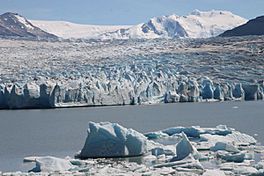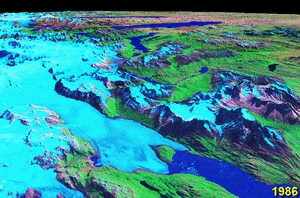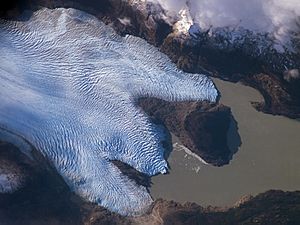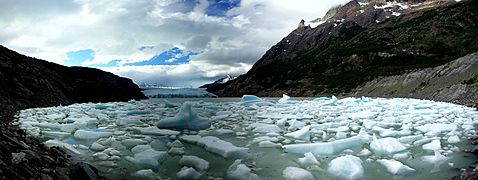Grey Glacier facts for kids
Quick facts for kids Grey Glacier |
|
|---|---|

Grey Glacier
|
|
| Type | Mountain glacier |
| Location | Chile |
| Coordinates | 50°57′S 73°15′W / 50.950°S 73.250°W |
| Area | 270 km2 (100 sq mi) |
| Length | 28 km (17 mi) |
| Terminus | Glacial lake |
Grey Glacier is a huge river of ice located in Chile. It's part of the Southern Patagonian Ice Field, which is a massive area of glaciers and ice. This amazing glacier flows south into a lake that shares its name, Grey Lake.
At its front, the glacier is about 6 kilometers (almost 4 miles) wide. It stands over 30 meters (about 100 feet) tall! In 1996, the glacier covered an area of 270 square kilometers (104 square miles). It was also 28 kilometers (17 miles) long. In November 2017, a very large piece of ice, called an iceberg, broke off from the glacier.
Where is Grey Glacier?
Grey Glacier is found at the southern end of the Southern Patagonian Ice Field. This ice field is a huge area of ice in Patagonia, shared by Chile and Argentina. The glacier is located on the western side of the famous Torres del Paine National Park.
You can see the surface of Grey Lake and the glacier from different spots. One great view is from John Garner Pass, which is part of a big hiking trail. Another way to see the glacier is from the south shore of the lake. From there, you can see the massive glacier in the distance. You might also spot pieces of ice floating near the shore.
Icebergs and the Glacier
When a glacier reaches a lake or the ocean, large chunks of ice can break off. This process is called calving. These broken pieces are known as icebergs. Grey Glacier often calves icebergs into Grey Lake. This is a natural part of a glacier's life cycle.
In November 2017, a particularly large iceberg broke away from Grey Glacier. This event showed how glaciers are constantly changing. Scientists study these changes to understand more about our planet.
Gallery
See also
 In Spanish: Glaciar Grey para niños
In Spanish: Glaciar Grey para niños
- List of glaciers





